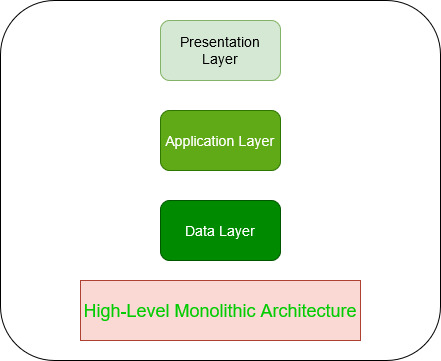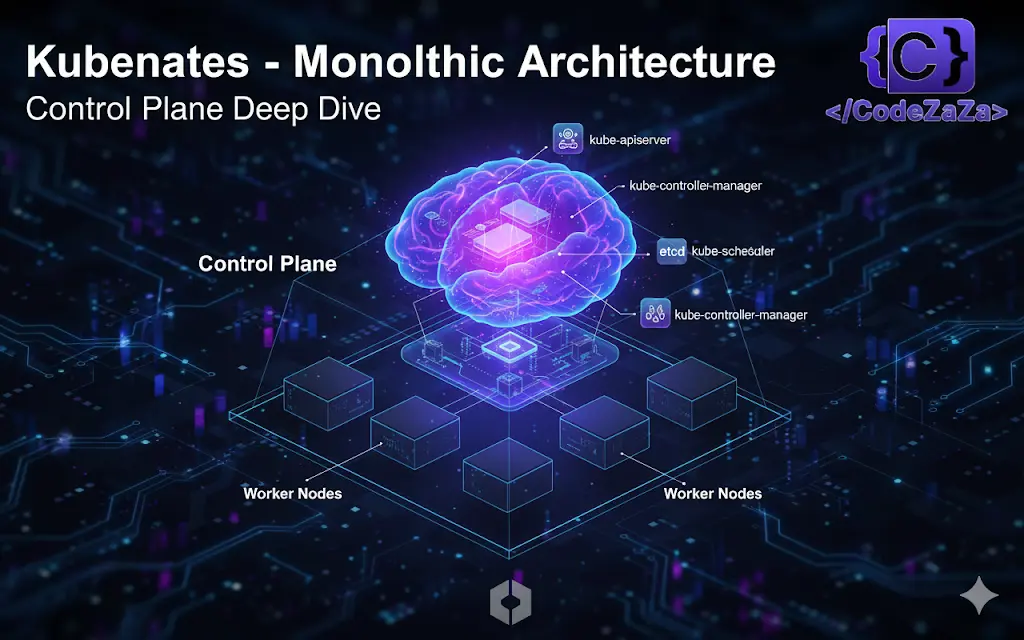There is a new way of developing software apps using a microservices architecture. That’s when all the buzz around containers and container orchestration has increased but we have been developing and using these large software apps even before most of us were born. So in this article, we will be discussing what is that old software architecture we used even before microservices and what are the disadvantages of it that led to shifting our focus to microservices.
What is monolithic?
In general, “monolithic” refers to something that forms a single large block—indivisible, inflexible, and self-contained. This concept highlights unity and a rigid structure.
In IT, a monolithic application follows a monolithic architecture. It bundles all parts of the application together and deploys them as a single unit. You can think of it as a large container where all software components are tightly packed and work as one.
For example, if you develop an application on the Java platform, you can package it using formats like .jar. You then deploy the entire package as a single unit onto an application server.
High-Level Monolithic Architecture:
- Presentation layer: At a high level the presentation tier is the front-end layer of the three-tier architecture. It is primarily a user interface of a web application. This tier is often built with web technologies such as HTML, Javascript, CSS, or through other popular web development frameworks and this tier communicates with the other two tiers at the bottom using API calls.
- Application tier: This is where you have all the business logic. It is often written in Java, Dotnet, C, Python, C++, or some more related languages.
- Data-tier: This is where all the data is stored and this data is accessed by the application layer when API calls. This tier consists of database technologies such as MySQL, Oracle DB, Microsoft SQL Server, MongoDB

So that’s a high-level overview of the monolithic architecture and its tiers. So all these layers are packaged and deployed together as one single unit and that is one of the main reasons why it is called monolithic architecture.
Now let’s look at an example of a simple monolithic application. When you take a bookstore web app it primarily consists of four components they are:
- Customer accounts
- Payments
- Inventory
- Shipping

So if the developer develops this application based on a monolithic ID picture then all these four components will be developed together which may be interdependent on each other and deployed onto a web server as one single unit.
Advantages & Disadvantages of Monolithic Architecture
With this architecture style of developing an application, there are some advantages and there are disadvantages and now it’s time to see some of the advantages and disadvantages of monolithic architecture.
Advantages of Monolithic Architecture:
- Single unit of deployment: Since it is a single unit of deployment so there is only one application to test and deploy overall. So monolithic applications are simple to develop and deploy.
- IDE support: We have been developing monolithic applications for almost two to three decades. It is mature and old so IDEs and other development tools are designed in sync with monolithic architecture in mind.
Disadvantages of Monolithic Architecture
- Large Applications: Monolithic applications often become very large. Small applications are easy to develop and maintain. However, in large applications with multiple components, developers may struggle to understand all business requirements and code. New team members especially require significant time to grasp the full application.
- Technology Dependency: Monolithic applications often get locked into the technologies chosen at the start. Even if better tools or languages emerge later, these applications must stick with their initial technology decisions.
- Single Stack Development: Monolithic design forces developers to use a single technology stack. Even if one component would benefit from a different technology, the architecture restricts flexibility.
- Impractical Frequent Deployments: Frequent deployments become challenging because all components are tightly linked. Coordinating multiple developers or departments to deploy and test new features or bug fixes can take hours or even days.
- Difficult to Scale: Scaling a monolithic application is hard because you must scale the entire application, not just specific components. This limits efficiency and increases resource usage.
Challenges of Monolithic Applications
Monolithic architecture served software development well for decades. Large organizations relied on this model and created effective ways to manage its limitations. However, the rise of the internet introduced new challenges, especially the unpredictable nature of user demands.
Predictable Internal Applications
Consider an internal company application used by 10,000 employees. In this case, the organization knows exactly how many employees log in daily, when they work, and how long they stay online. With this information, IT teams can allocate just enough resources to ensure smooth performance. When more employees join, the company can plan ahead and add resources gradually.
Unpredictable External Applications
Now imagine an external e-commerce site, like Amazon or Walmart. Unlike internal systems, the number of visitors can’t be predicted with certainty. Historical data may help estimate traffic, but sudden spikes—caused by holiday sales, marketing campaigns, or social media buzz—can drastically increase demand overnight.
Scaling Issues in Monolithic Applications
When traffic surges, monolithic applications struggle to scale quickly. Unlike modern architectures, they lack the flexibility to add resources dynamically in real time. If the infrastructure cannot keep up, application performance drops, and in extreme cases, the system may crash.
The Core Problem
This was a common issue in the early days of the internet. Monolithic applications often slowed down or failed entirely when user demand spiked. The fundamental challenge lies in their inability to scale resources dynamically, making them less suitable for today’s unpredictable digital landscape.
Conclusion
Monolithic architecture has been the backbone of software development for decades. It offers simplicity in deployment, strong IDE support, and a mature ecosystem of tools. However, as applications grow in size and user demands become unpredictable, its limitations become clear. Scaling, technology lock-in, and tightly coupled components make monolithic applications harder to manage in today’s dynamic environment.
This is why modern organizations have shifted their focus to microservices architecture, which allows independent scaling, flexibility in technology choices, and faster deployments. While monolithic applications still serve well for smaller projects, microservices have become the go-to model for building scalable, resilient, and future-ready applications


